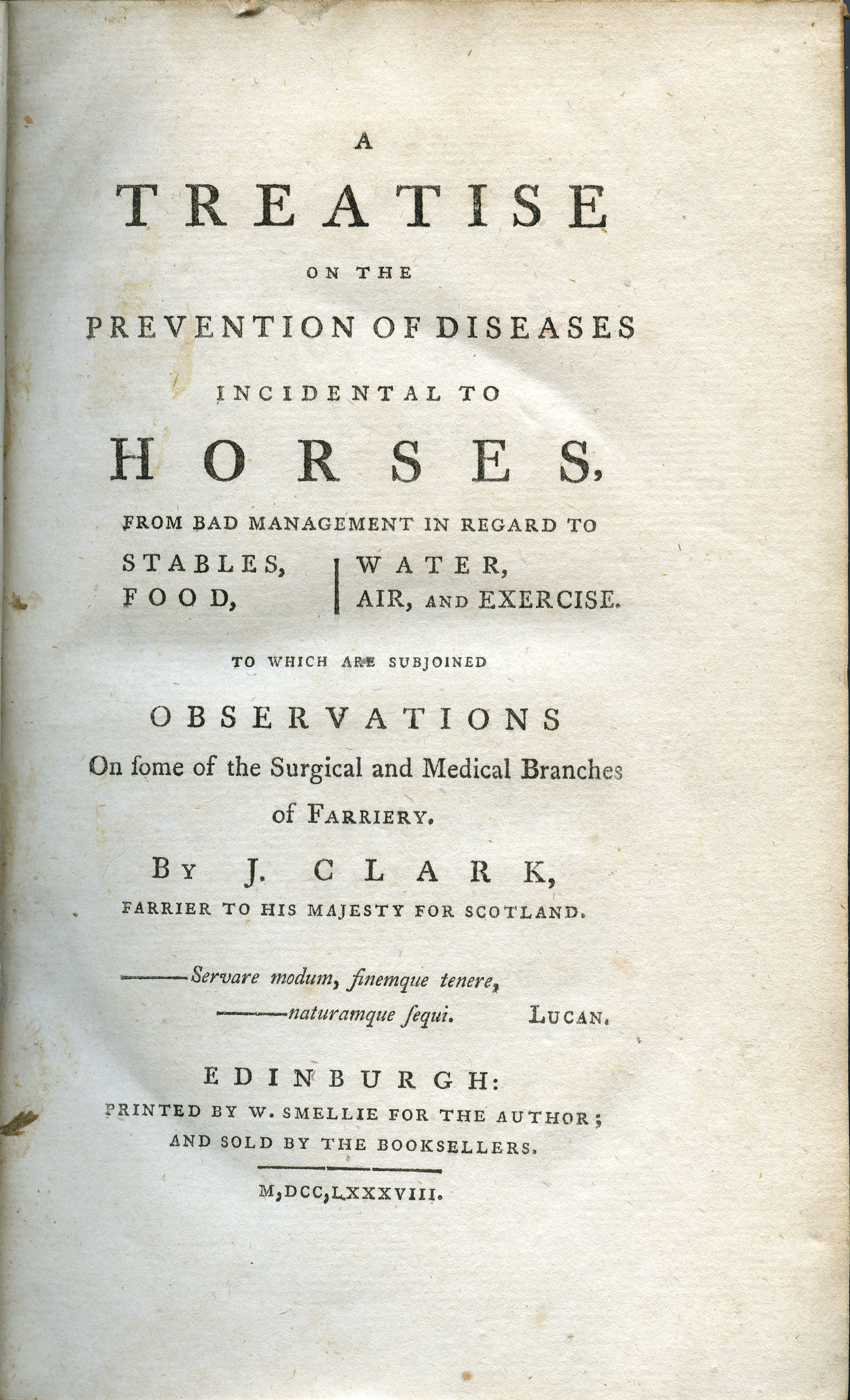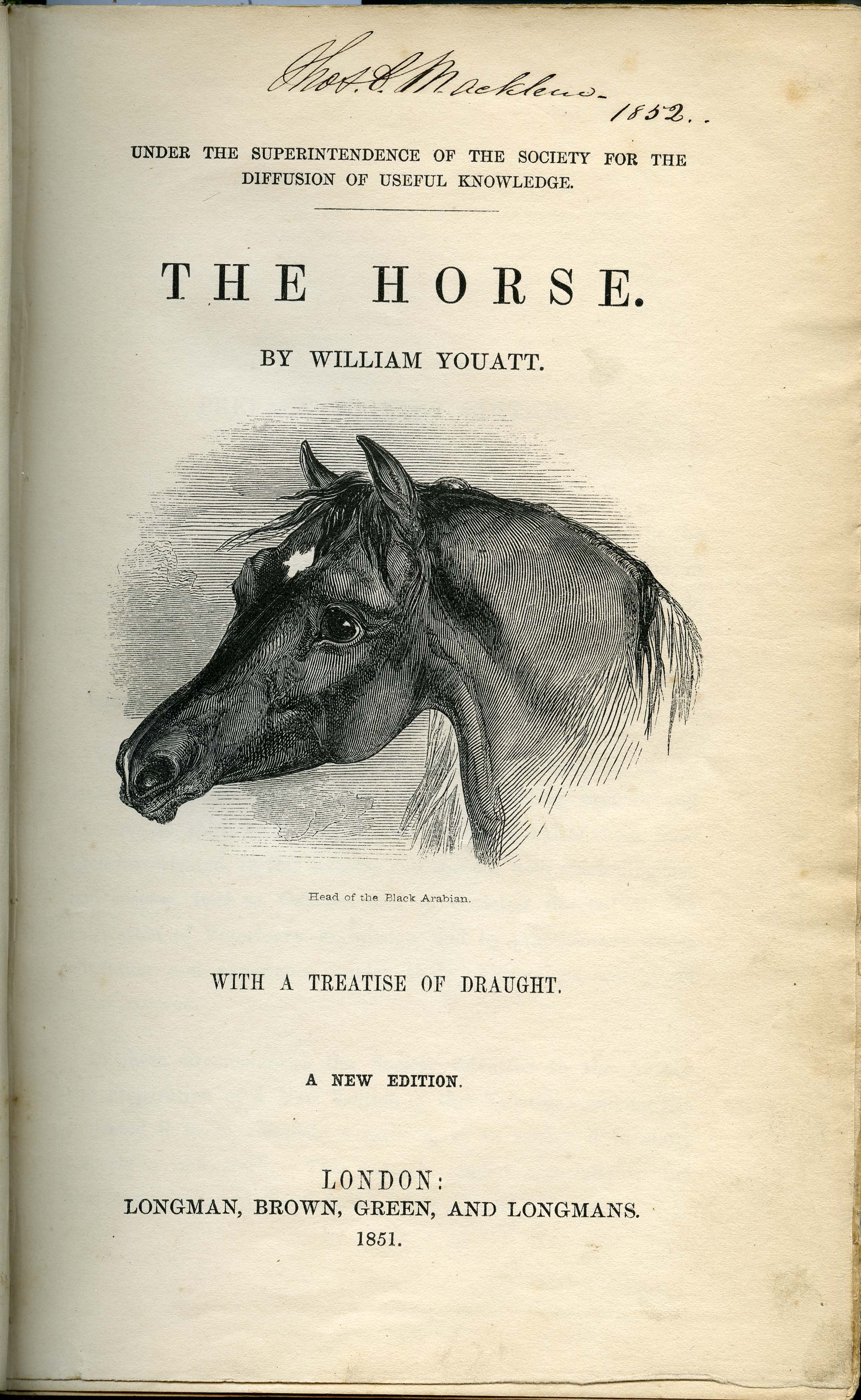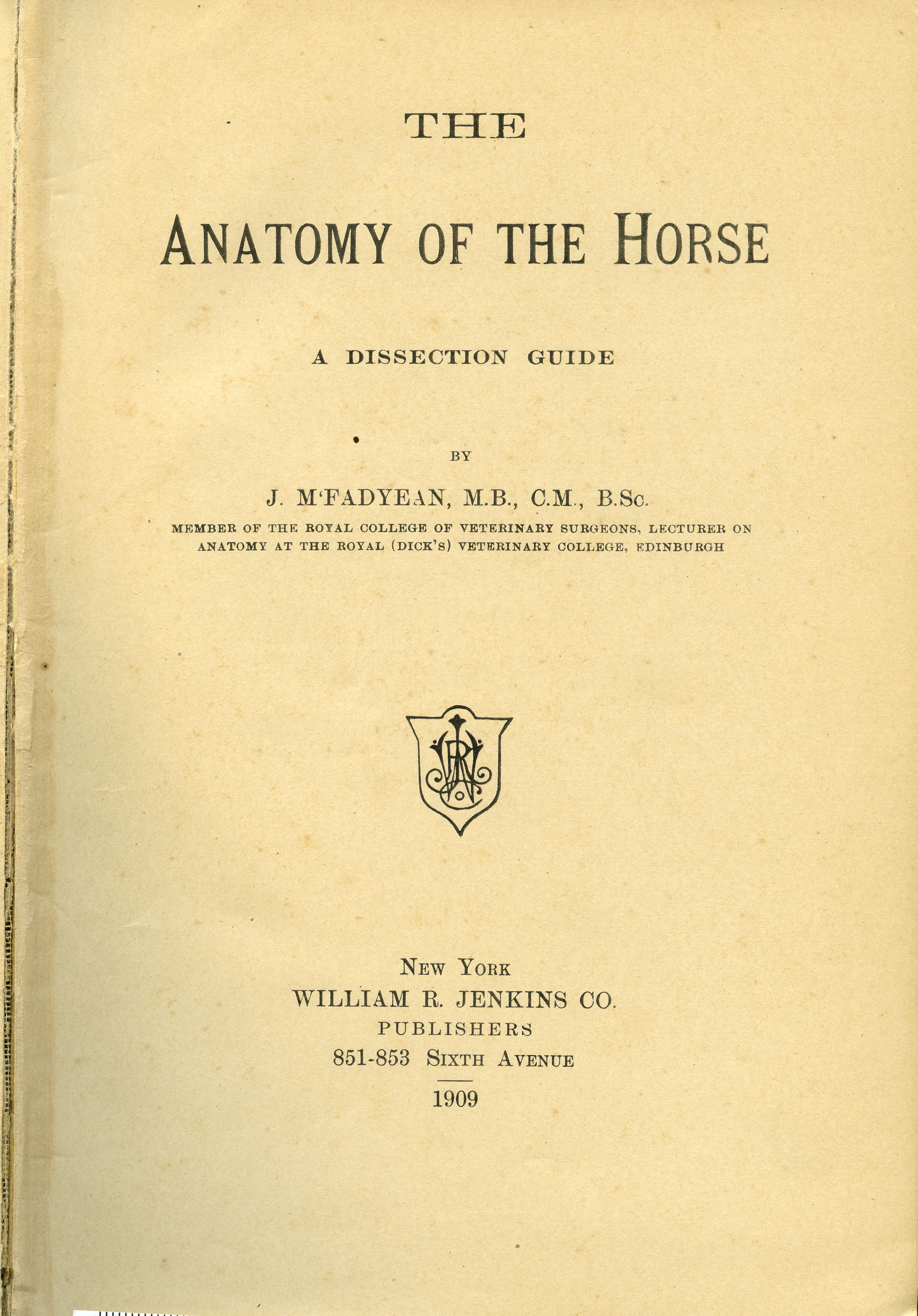Veterinary Researchers
Several of the most influential practitioners of veterinary art with works in the Rosen collection were researchers who laboured, often in multiple roles, as private practitioners, as educators at veterinary schools, and as promoters/organizers of the veterinary profession. They published the results of their research for the benefit of colleagues, students, their clients, and in support of the evolving profession. The researchers are listed in loose chronological order of dates during which they were active, because different professional and societal trends applied over time. Among those researchers represented with works in the Rosen collection are James Clark, William Youatt, James White, Edward Mayhew, John Stewart, George Gresswell, Frederick Hobday, and John Mcfadyean. Longer biographies for researchers Clark and Youatt are found in the Biographies section.
James Clark (173?-1808) was an accomplished Edinburgh veterinarian and scientific writer who graduated from the University of Edinburgh in 1765/66 and studied human and comparative anatomy. In alignment with his interests in research and writing, Clark published three well-received books which extended to subsequent editions. His works indicate that he was ahead of his time in understanding the value of firstly developing, and then applying, the principles of veterinary hygiene and humane treatment in raising animals in good health. Clark was also an active promoter of the formation of veterinary schools for training veterinarians; he particularly desired a school in Edinburgh.
He published his first veterinary textbook Observations Upon the Shoeing of Horses with an Anatomical Description of the Bones in the Foot… in 1770 which was the one that established his reputation as a craftsman with a scientific writing style. Clark was a pioneer in scientific veterinary writing and influenced writers in the later century, notes Smithcors (1957, p. 273). In 1788, he published the second textbook, A Treatise on the Prevention of Diseases Incidental to Horses: From Bad Management in Regard to Stables, Food, Water, Air and Exercise (a copy is in the Rosen collection). Clark’s third work was volume one of First Lines of Veterinary Physiology and Pathology in 1806; a textbook intended for veterinary students.
Clark was a pioneer in scientific veterinary writing and influenced writers in the later century, notes Smithcors (1957, p. 273).
William Youatt (1776-1847) is well-known in the history of veterinary medicine to have contributed positively to the evolution of the profession in Britain and North America. He graduated later in life from the Royal Veterinary College in London and addressed in his writings the diseases of all domestic animals, not just the horse. Youatt’s broad views of the veterinary profession included interests in veterinary education, writing, as editor of The Veterinarian journal, as well as in public discourse on animal and public health issues. “The profile of veterinary medicine to the general public was raised when Youatt’s lectures on his work on horses, cattle, sheep, swine, horses and dogs were reprinted in the Farmer and Gardener magazine in the US" (Bierer, 1955, p. 33).
Youatt published a series of books on the major domestic species under the supervision of the Society for the Diffusion of Useful Knowledge. From 1834-1847 Youatt wrote: The Horse-its Breeds, Management and Diseases; Cattle-Their Breeds, Management, and Diseases; Sheep-its Breeds, Management, and Diseases, with the Mountain Shepherd’s Manual; and The Dog. He edited the last edition of The Complete Grazier by Thomas Hartwell Horne. Posthumously published were The Pig-a Treatise on the Breeds, Management, and Medical Treatment of Swine, with Instructions for Curing Hams and Bacon in 1847, and multiple editions of Youatt on the Structure and the Diseases of the Horse. The Rosen collection includes editions of all Youatt’s works except for the book on swine, which is in the University of Saskatchewan's Veterinary Medicine Rare collection.
James White (d. 1825) was a veterinary surgeon of the First or Royal Dragoons. He wrote a 4-volume work (available in the Rosen collection) called A Treatise on Veterinary Medicine with a new edition every other year until the 17th in 1842.
White’s Volume 1 was entitled (in all its fullness), A Compendium of the Veterinary Art: Containing Plain and Concise Rules for the Treatment of All the Disorders and Accidents to Which the Horse is Liable, with Observations on Grooming, Feeding, Exercise, and the Construction of Stables: Also, a Brief Description of the Structure, Economy, and Diseases of the Horse's Foot, With the Principles and Practice of Shoeing.
Volume 2 was A Treatise on Veterinary Medicine: Containing the Materia Dietetica, Materia Medica and Pharmacopoeia,
Volume 3 was A Treatise on Veterinary Medicine: Containing Practical Observations on the Structure, Economy and Diseases of the Digestive Organs of the Horse, and Other Diseases Resulting From Them; Also Practical Observations on the Treatment and Prevention of Lameness.
Volume 4 was A Treatise on Veterinary Medicine: A compendium of Cattle Medicine.
The 17th edition of A Treatise was revised by W.C. Spooner in 1842, and became a single volume called A Compendium of the Veterinary Art… after White's death. The title page from the 17th edition in 1842 was “... entirely reconstructed with considerable additions and alterations bringing the work up to the present state of veterinary science”. Spooner continued White’s practice in the preface of his volumes of providing a “… short account of the works of living veterinary authors...” (Spooner, 1842, p. iii).
Edward Mayhew (1808-1868) came to veterinary medicine at the age of 35 years and qualified as a member of the RCVS on 6 February 1845. He changed careers from authoring dramatic productions and literary submissions to practising veterinary medicine. He became a member of RCVS Council in 1846. In a time when most veterinarians were focussed on treating animals of economic values, i.e. horses, Mayhew was ahead of his time by including companion animals in his research. His research involved using inhalation anaesthesia as an aid to surgery and he tested ether on cats, dogs, cows and horses (Dunlop and Williams, 1996, p. 606). He used ether during an extraction of one of his own teeth to ensure that animals were not suffering during surgical procedures. His concern for animal welfare in veterinary practice is demonstrated in the preface of The Illustrated Horse Doctor when he writes “In the writer’s conviction, humanity toward animals should be more commonly practiced– if not from any higher motive, because it is certainly the truest economy. To make this fact plain is the intention of the present publication” (Mayhew, 1862, p. 11).
“In the writer’s conviction, humanity toward animals should be more commonly practiced – if not from any higher motive, because it is certainly the truest economy. To make this fact plain is the intention of the present publication” (Mayhew, 1862, p. 11), The Illustrated Horse Doctor. ).
He organized his newfound veterinary knowledge and eventually published three books on dogs and horses, and revised Blaine’s Outlines of Veterinary Medicine (the latter is not in the Rosen collection). While preparing these books, and for the following 15 years, he was incapacitated due to a ‘paralytic affliction’ during which he was unable to walk (Hodder, 1870, p. 60). The Rosen collection includes a first American edition of The Illustrated Horse Doctor published in 186?, and Dogs and Their Management authored with Alfred J. Sewell, 3rd edition revised by Frederick W. Cousens, 1943. Mayhew provided most of the illustrations for both of The Illustrated Horse Doctor and Illustrated Horse Management.
John Stewart (1810-1896) was a graduate of Edinburgh veterinary school in 1827 who practised in Glasgow and then emigrated to Australia in 1840. Although Stewart left the country of his birth as a young man, his experience and opinions about veterinary medicine became known through his written works that appeared in multiple editions. In Australia he practiced until 1852 when he became active in politics. One of Stewart’s works in the Rosen collection is Stable Economy, 2nd ed.,1838. The 7th edition was the final one published in 1860. Describing Stewart’s Stable Economy , Smith says, “In these pages we get the full benefit of his experience, close observation, sound logical common sense, and practical knowledge as a horse-master. No summary of this work could do it justice. It is a mine of wealth in all that relates to the care and management of working horses, and it may be read today with the same profit as over ninety years ago”.
“We have few veterinary classics [ Stable Economy ]: this is one” (Smith, 1976b, p. 46).
Works by Stewart missing from the Rosen collection are Advice to Purchasers of Horses and A Concise Account of Veterinary Surgery, its Schools and Practitioners . Stewart wrote Advice to Purchasers of Horses that went through several printings from 1831 to 1844 including an American edition. Its intended audience included the horseman and lawyer because it contained information on buying and selling horses and determining conformation and soundness in horses. Smith says, “The pages of this booklet are worth printing in letters of gold” (Smith 1976b, p. 44). A Concise Account of Veterinary Surgery, its Schools and Practitioners … was published anonymously by a Veterinary Surgeon in 1834. Stewart, in 1835, admitted to being its author. He took aim at the Edinburgh and London schools for deficiencies in their educational offerings especially by focussing overly on horses to the exclusion of other species. He also advocated that medical students should learn about veterinary medicine and surgery.
George Gresswell (no dates) revised The Bovine Prescriber: Drawn Up for Veterinary Practitioners and Students and The Equine Hospital Prescriber: Drawn Up for Veterinary Practitioners and Students , both books were written by J. Brodie Gresswell and Albert Gresswell. According to George Gresswell (1894, p. viii) in the Preface to The Bovine Practitioner, “The prescriptions are made up – except when otherwise stated for adult oxen. Sheep are acted upon in a very similar manner, proved that about one-fifth or one-sixth of the dose be given.”
The Veterinary Journal Reviews, 1894, noted of The Bovine Prescriber, “This handy little work was first published in 1886, for the use of veterinary practitioners and students and a new edition has now been issued, showing that it has met a demand and done its duty. The book has been overhauled by Mr. George Gresswell, who has improved and enlarged it, and by doing so has made it more acceptable to those for whom it was intended. The arrangement is best for immediate reference, and the details are apparently carefully elaborated. We cannot discover anything of importance omitted, though, here and there some of the items are not quite up to date. But the Bovine Practitioner must be considered a most useful handbook for the busy practitioner, who cannot carry in his head all the knowledge he requires, and has to refer to convenient guides like the present for immediate information.” The Rosen collection contains the 2nd edition, 1894, of The Bovine Prescriber , and a Canadian imprint of the 3rd edition of The Equine Hospital Prescriber, published in 1904.
“The prescriptions are made up – except when otherwise stated for adult oxen. Sheep are acted upon in a very similar manner, proved that about one-fifth or one-sixth of the dose be given.” George Gresswell (1894, p. viii) in the Preface to The Bovine Practitioner.
Frederick G.T. Hobday (1870-1932) was a successful veterinary educator and clinician and researcher who developed (and performed many times) a surgical technique for relieving roaring in horses. In praise of Hobday, “More than any other individual, he showed the way to the development of effective small animal medicine and surgery” (Dunlop and Williams, 1996, p. 608). Hobday also introduced the development of veterinary anesthesia and x-ray technology in small animal practice (Dunlop and Williams, 1996, p. 608). He designed and developed anesthetic equipment such as a bellows that controlled the delivery of gases to the patient and reduced the mortality of inhalation anesthesia in dogs. Hobday served as a surgical consultant in WWI, and later, was in command of Veterinary Hospital No. 22 at Abbeville, France, “…the largest reception hospital for horses and mules on the Western Front" (Hall, 2006, p. 131).
“More than any other individual, he [Hobday] showed the way to the development of effective small animal medicine and surgery” (Dunlop and Williams, 1996, p. 608).
Several of Hobday’s texts are in the Rosen collection including: Canine and Feline Surgery, British and American editions that were published in 1900; The Castration of Cryptorchid Horses and the Ovariotomy of Troublesome Mares, 1903; and Surgical Diseases of the Dog and Cat, 3rd edition published in 1924. Hobday revised Edward Courtenay’s Manual of the Practice of Veterinary Medicine, 3rd edition released in 1913. In Canine and Feline Surgery Hobday paid attention to "... the necessity of hygiene, both personal and of surgical instruments, and the use of antiseptics to avoid bacterial infection" (Swabe, 1999, p. 179). In 1927, he was appointed Principal of London's Royal Veterinary College bringing his interest in small animal practice to the mix of subjects taught at the school.
John Mcfadyean (1853-1941) qualified at the Dick School in Edinburgh in 1876 and was a lecturer for the next eleven years. He had no interest in establishing his own practice preferring instead to influence the veterinary profession through educational reform and scientific research. During his early years as a lecturer at the Dick School, he attended classes in science and medicine, because of his interest in pathology and the new field of bacteriology. He graduated from the Edinburgh Medical School in 1882, and was the only veterinary pathologist in Britain. In 1888, he established the Journal of Comparative Pathology and Bacteriology in alignment with his scientific interests, and also to promote educational reform by including the microbiological sciences in the veterinary curriculum. Mcfadyean was the sole editor for 50 years; the serial continues today as The Journal of Comparative Pathology.
He moved to London in 1892 and was appointed Dean and Professor of Pathology and Bacteriology at the Royal Veterinary College. In 1894, he was appointed Principal of the RVC and served until his retirement in 1927. He was a powerful influence on the Council of the Royal College of Veterinary Surgeons and was active in promoting the profession. As a scientist himself, Mcfadyean supported the development of scientific veterinary training, but was against university integration because he believed it would weaken the profession by ceding power to external bodies. Mcfadyean was a traditionalist, who as a member of the RCVS Council, was protective of the segregated system of veterinary education, and the one-portal entry to the profession by the MRCVS, the membership diploma of the RCVS. He was embroiled in the “university integration” issue that had divided the veterinary profession. In 1905 he was knighted specifically for his work as a veterinary surgeon, public acknowledgement of an accomplished member of the profession.
He wrote numerous articles and reports published in his journal, and two textbooks: The Anatomy of the Horse: a Dissection Guide, 1909, which is in the Rosen collection; and The Comparative Anatomy of the Domesticated Animals. Part I: Osteology and Arthrology, 1908, not found in the University collection.



Agricultural Writers
Surgeon-Veterinarians
Military Veterinarians

